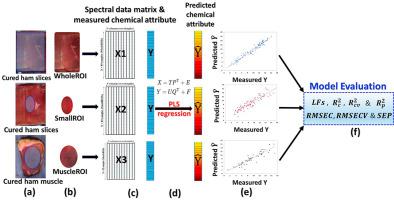Biosystems Engineering ( IF 5.1 ) Pub Date : 2020-12-05 , DOI: 10.1016/j.biosystemseng.2020.11.008 Gamal M. ElMasry , Elena Fulladosa , Josep Comaposada , Salim S. Al-Rejaie , Pere Gou

|
Sliced dry-cured ham arranged in ready-to-eat packages is a convenient and widely consumed commodity characterised by heterogeneity in composition not only among different industrial batches but also through their horizontal and vertical profiles, making precise nutrition labelling of the packages a difficult task. Hyperspectral imaging techniques can serve as a steadfast solution not only to predict the overall composition of the major constituents of dry-cured ham but also to visualise their distributions. The main aim of this study was to define the optimal protocol for pretreating hyperspectral images and selecting representative hyperspectral data for developing accurate predictive models in excessively heterogeneous samples, using sliced dry-cured ham as a case study. Hyperspectral images (400–1000 nm) were acquired for heterogeneous sliced dry-cured ham and homogeneous unsliced dry-cured muscles. Partial least squares (PLS) regression models to predict fat, water, salt and protein contents were developed and tested in an independent dataset. The PLS predictive models developed from the whole surface of sliced dry-cured ham were the most accurate ones for predicting fat, water, salt and protein contents with a determination coefficient in prediction () of 0.89, 0.85, 83 and 0.63 and standard error in prediction (SEP) of 1.43, 1.21, 0.51 and 1.57%, respectively. The chemical images resulting from the models gave advantages of hyperspectral imaging technique over traditional chemical methods to visualise the spatial distribution of different constituents within the packaged ham slices.
中文翻译:

具有代表性的高光谱数据的选择和图像预处理以用于异质样品中的模型开发:以切成薄片的干腌火腿为例
安排在即食包装中的切片干腌火腿是一种方便且被广泛使用的商品,其特点是不仅在不同的工业批次之间,而且在水平和垂直方向上均具有异质性,因此很难对包装进行准确的营养标签。高光谱成像技术不仅可以预测干腌火腿主要成分的总体组成,而且可以直观地显示其分布,从而成为一种可靠的解决方案。这项研究的主要目的是使用切片干火腿作为案例研究,确定用于预处理高光谱图像和选择代表性高光谱数据的最佳方案,以开发出过多异质样品中的准确预测模型。对于异质切片的干腌火腿和均质的未切片干腌的肌肉,均获得了高光谱图像(400-1000 nm)。开发了预测脂肪,水,盐和蛋白质含量的偏最小二乘(PLS)回归模型,并在独立的数据集中进行了测试。从切成薄片的干腌火腿的整个表面建立的PLS预测模型是最准确的预测脂肪,水,盐和蛋白质含量的模型,其预测系数为()分别为0.89、0.85、83和0.63,预测标准误差(SEP)分别为1.43、1.21、0.51和1.57%。与传统化学方法相比,由模型产生的化学图像提供了高光谱成像技术的优势,可直观显示包装火腿切片中不同成分的空间分布。

























 京公网安备 11010802027423号
京公网安备 11010802027423号